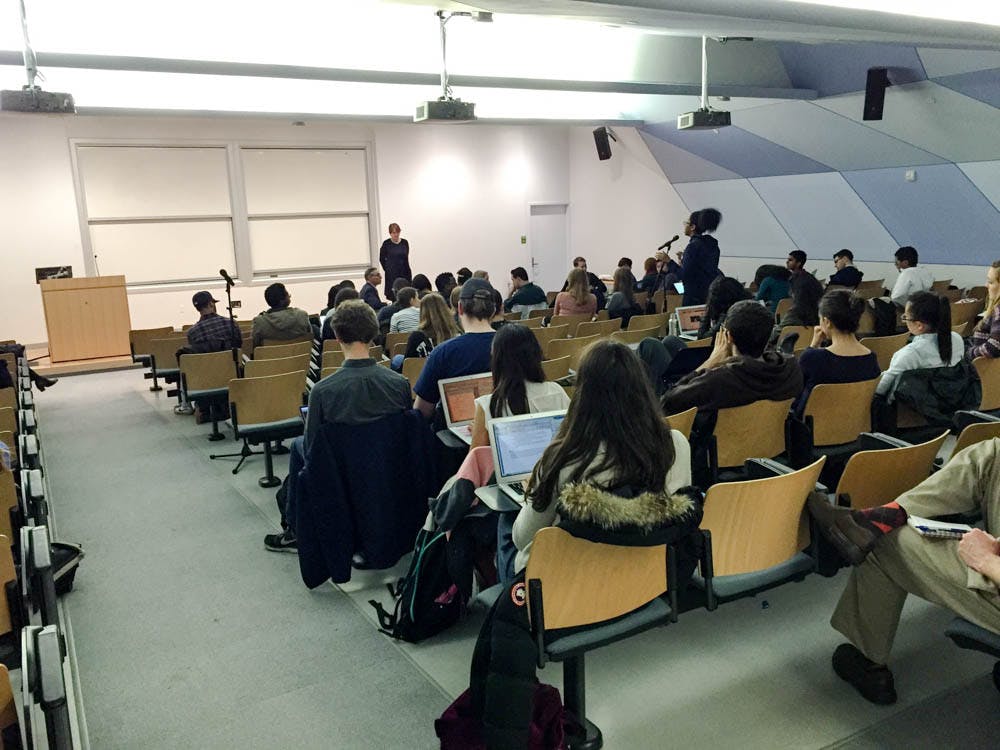President Christina Paxson P’19 and other University administrators emphasized the progress made in the fields of diversity and inclusion at the annual State of Brown address and public forum hosted by the Undergraduate Council of Students Tuesday.
UCS President Sazzy Gourley ’16 welcomed Paxson to the forum, held in a half-full lecture hall in the Building for Environmental Teaching and Research. “We’re grappling with how to build a community where all students, faculty and staff feel they belong,” Gourley said in his introduction.
Paxson opened her remarks by citing Brown’s mission statement, which “guides almost everything we do,” she said. “This is an academic institution,” Paxson said. “We’re here to learn, but in ways that make the world better.”
As the implementation of the Diversity and Inclusion Action Plan continues, individual departments and centers are beginning to develop their own plans in accordance with the policy, Paxson said. These departmental teams are “thinking hard about ways in which they can increase the diversity of their faculty,” she added.
Other actions in line with the DIAP include the hiring of a dean for diversity issues in the Graduate School and a new staff member for the LGBTQ Center and the creation of a task force focusing on diversity across curriculums. “The goal is to create a more inclusive learning environment,” Paxson said.
Paxson also announced the creation of the First Generation College Student Center, to open in the Sciences Library this summer. This initiative arose directly from student advocacy efforts, she added.
After the introduction, Paxson opened up the floor for questions from students. Administrators including Provost Richard Locke P’17, Dean of the College Maud Mandel, Vice President for Planning and Policy Russell Carey ‘91 MA’06 and Vice President for Academic Development, Diversity and Inclusion Liza Cariaga-Lo answered questions along with Paxson.
Candice Ellis ’16 expressed concerns that the Office of Institutional Diversity and Inclusion is shouldering a disproportionate share of the burden when it comes to oversight and education on diversity issues. Paxson responded by highlighting the importance of the DIAP functioning as a community-wide effort. “If it’s coming only from (Cariaga-Lo’s) office, it’s going to fail,” she said.
“We don’t want this plan to fail because we’re putting too much burden on people who already have too much work,” Locke added.
Ellis and Alexandra Sepolen ’16 brought up the issue of expenses associated with Senior Week and Commencement, such as graduation attire and transportation for family members. “There isn’t a consolidated list of commencement-related expenses for seniors,” Sepolen said.
Efforts are being made to deal with this lack of information, Mandel said. The University is hiring an Assistant Dean for Financial Advising that will, among other duties, provide details about commencement expenses to seniors, she added.
“It’s critical that we communicate that at the beginning of the year,” Ellis responded. While some graduation expenses are technically optional, she warned against seeing them as such. “We’re not going to walk through the gates in our jeans,” she added.
Olivia Veira ’17 asked how administrators will ensure that voices in the Providence community are being heard in the process of implementing the DIAP. The Swearer Center “collected community input while the plan was being put together, and I expect that will continue,” Paxson said in response.
“There is a lot of community outreach,” Carey said. There will be Providence community representation on the Public Safety Oversight Committee, he added.
Training for the Department of Public Safety is also a primary action area of the DIAP. The curriculum for officer training is “rigorous,” Carey said, but the OIDI is helping to institute additional training. “We’re committed to doing quite a bit more,” he added.
Tim Ittner ’18 asked for an update on the state of the arts at Brown. The strategic plan includes the creation of a new performing arts center, Paxson said. It will take shape as “an innovative performance space that can be used for orchestra as well as various forms of music, multimedia and dance,” she added. “We have strong programs in theater, dance and visual art, but we also have many students that aren’t majoring in the arts that are extremely engaged.”
Administrators also discussed facilities renovations, particularly those associated with accessibility. The issue of Wilson Hall, a building virtually off-limits to students requiring handicapped access, was emphasized. “We are planning to move forward” with renovations to Wilson, Mandel said. Perkins Hall and Barbour Hall, both primarily sophomore dormitories, will be renovated this summer, Paxson added.
Correction: A previous version of this article stated that Candice Ellis ’16 and Alexandra Sepolen ’16 brought up the issue of expenses associated with Senior Week. In fact, they brought up the issue of expenses associated with both Senior Week and Commencement. The Herald regrets the error.





